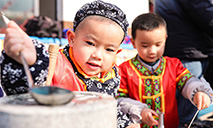Lion dance tradition gains strength through animation comedy
GUANGZHOU, Dec. 30 (Xinhua) -- Chinese animation comedy "I Am What I Am" has caused a sensation as it brings lion dance to the big screen and injects new vigor into this intangible cultural heritage.
The movie has accumulated a high score of 8.3 points out of 10 based on more than 160,000 reviews on the review platform Douban since its opening on Dec. 17, with a total box office revenue of 157 million yuan (about 24.6 million U.S. dollars) as of Thursday, according to box office tracker Maoyan.
Unfolding from a brief introduction to lion dance, a centuries-old Chinese folk dance often staged for entertainment on festive occasions, the film follows an underdog teenager in Guangdong, south China, as he joins hands with two friends to pursue a dream against all odds -- becoming the best lion dance performer.
Reminiscing on his 10-plus years of life in Guangdong, the film's director Sun Haipeng said the lion dance has been an indispensable part of local life. Whenever the beating of drums and clanging of gongs were heard, people rushed out to watch.
The lion dance is one of the most widespread folk dances in China. In Chinese culture, the lion is regarded as a mascot, which can bring good luck.
"This (lion dance) is a cultural activity combining traditional and modern elements. It is old but with vitality," Sun said, adding that he always wanted to tell reality-themed stories through animation.
"We brought the lion dance tradition to the big screen because we want more people, the young in particular, to establish emotions with traditional Chinese cultural elements," said Zhang Miao, executive producer of the animation.
"We couldn't help but shed tears as we watched the movie. It tells our story. We are ordinary people, but feel rejuvenated whenever we raise up the lion head," said Zhao Weibin, a Guangdong-based inheritor of lion dance.
Zhao went to the cinema with his dozens of students dedicated to the lion dance. He has held out for dreams to promote lion dance among more young Chinese.
"Bolstering intangible cultural heritage inheritance among the young is very important. The lion dance involves martial art, dance and music, which can strengthen their minds and bodies," he said.
Currently, the lion dance has been introduced into 176 schools in Guangzhou, the provincial capital of Guangdong, covering nearly 20,000 students.
"We must keep up with the times, and integrate modern elements like technology and fashion into the lion dance tradition. Thus, more young people would love it and be willing to learn and carry forward this traditional folk art," Zhao said.
Photos
Related Stories
Copyright © 2021 People's Daily Online. All Rights Reserved.










